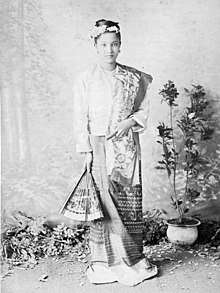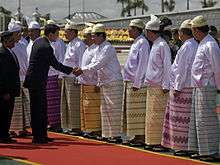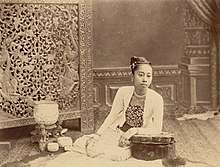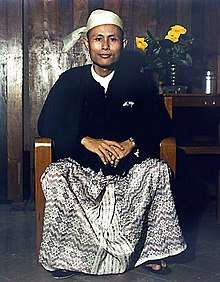Burmese clothing
| Part of a series on the |
| Culture of Myanmar |
|---|
_peacock.svg.png) |
| History |
| People |
|
Mythology and folklore |
| Cuisine |
| Literature |
|
Monuments |
|
Clothing in Myanmar varies depending on the ethnicity, geography, climate and cultural traditions of the people of each region of Myanmar (Burma). The most widely recognized Burmese national costume is the longyi, which is worn by both males and females nationwide. Burmese clothing also features great diversity in terms of textiles, weaves, fibers, colours and materials, including velvet, silk, lace, muslin, and cotton.
History
Pre-colonial era

In the pre-colonial era, sumptuary laws called yazagaing dictated life and consumption for Burmese subjects in the Konbaung kingdom, everything from the style of one's house to clothing suitable to one’s social standing from regulations concerning funerary ceremonies and the coffin to be used to usage of various speech forms based on rank and social status.[1][2][3] In particular, sumptuary laws in the royal capital were exceedingly strict and the most elaborate in character.[4] Sumptuary regulations regarding dress and ornamentation were carefully observed. Designs with the peacock insignia were strictly reserved for the royal family and long-tailed hip-length htaingmathein jackets and surcoats were reserved for officials.[5] Velvet sandals were worn exclusively by royals.[6] Gold anklets were worn only by the royal children. [1] Silk cloth, brocaded with gold and silver flowers and animal figures were only permitted to be worn by members of the royal family and ministers’ wives. [1] Adornment with jewels and precious stones was similarly regulated. Usage of hinthapada (ဟင်္သပဒါး), a vermilion dye made from cinnabar was regulated.[1]
Colonial era

During the British colonial era, Burmese nationalists associated traditional clothing, in particular Yaw longyi (ယောလုံချည်), a type of longyi from the Yaw region, and pinni taikpon (ပင်နီတိုက်ပုံအင်္ကျီ), a fawn-coloured collarless jacket, with anti-colonialism and nationalist sentiment, because of a clampdown in the 1920s over increasing dissent.[7] Wearing "traditional" clothing was seen as a mode of passive resistance among the Burmese.[7] The female sarong (htamein) became shorter, no longer extending to the feet, but to the ankles, and the length of the sarong's top decreased to reveal more waistline.[8] This period also saw the introduction of a sheer muslin blouse for women, revealing a corset-like lace bodice called za bawli (ဇာဘော်လီ). British rule nonetheless influenced hair fashion and clothing. Cropped short hair, called bo ke (ဗိုလ်ကေ) replaced long hair as the norm among Burmese men.[8] Similarly, women began wearing hairstyles like amauk (အမောက်), consisting of crested bangs curled at the top, with the traditional hair bun (ဆံထုံး).[8]
Modern era
.jpg)
National costumes
Longyi

The national costume of Myanmar is the longyi (လုံချည်, Burmese pronunciation: [lòʊɴd͡ʑì]), an ankle-length wraparound skirt worn by both males and females. The longyi in its modern form was popularized during the British colonial period, replacing the traditional paso worn by men and htamein worn by women in pre-colonial times. The pre-colonial htamein features a broad train called yethina (ရေသီနား) and is only seen in modern times as wedding attire or a dance costume. Similarly, the pre-colonial paso is only commonly worn during stage performances, including dances and anyeint performances.
Acheik textiles

The indigenous Burmese pattern, called acheik (အချိတ်; [ʔət͡ɕʰeɪʔ]), features intricate waves interwoven with bands of horizontal stripes, embellished with arabesque designs. Acheik is also known as luntaya (လွန်းတစ်ရာ; [lʊ́ɴtəjà]), which literally means a "hundred shuttles,"[9] referring to the time-consuming, expensive, and complex process of weaving this pattern, which requires using numerous individual shuttles, each wound with a different color of silk.[10] Acheik weaving originates in Amarapura,[11] and became popular during the Konbaung dynasty.
Taikpon jacket
For business and formal occasions, Bamar men wear a Manchu Chinese jacket called a taikpon eingyi (တိုက်ပုံအင်္ကျီ, [taɪʔpòʊɴ]) over an English collar shirt. This costume was popularized during the colonial era.
Female eingyi
Burmese women wear blouses called eingyi (အင်္ကျီ [ʔéɪɴd͡ʑì]). There are two prevalent styles of eingyi: yinzi (ရင်စေ့) buttoned at the front, or yinbon (ရင်ဖုံး), buttoned at the side. For formal and religious occasions, Burmese women typically don a shawl.
Htaingmathein jacket

The most formal rendition of Myanmar's national costume for females includes a buttonless tight-fitting hip-length jacket called htaingmathein (ထိုင်မသိမ်း[tʰàɪɴməθéɪɴ]), sometimes with flared bottoms and embroidered sequins. Htaingmathein in Burmese literally means "does not gather while sitting," referring to the fact that the tight-fitting jacket does not crumple up when sitting. This jacket was popular among the aristocratic classes during the Konbaung dynasty, and is now most commonly worn by females as wedding attire, or as traditional dance costume. The htaingmathein is worn over a bodice called yinkhan (ရင်ခံ, [jɪ̀ɴkʰàɴ]). Historically, the htaingmathein also had a pair of pendulous appendages on both sides called kalano (ကုလားနို့).
Gaungbaung

The Burmese national costume for men includes a turban called gaung baung (ခေါင်းပေါင်း, [ɡáʊɴbáʊɴ]), which is worn for formal functions. During the colonial era, the gaung baung was streamlined as an article of Burmese attire. The design of the modern Burmese gaung baung emerged in the mid-1900s and is called maung kyetthayay (မောင့်ကျက်သရေ).[12] It is a ready-made gaung baung made of cloth wrapped in a rattan frame and can be worn like a hat is worn.
Formal footwear
Both genders wear velvet sandals called gadiba phanat (ကတ္တီပါဖိနပ်, also called Mandalay phanat) as formal footwear.
Regional costumes
The various ethnic groups of Myanmar all have distinct clothing and textile traditions.
See also
References
| Wikimedia Commons has media related to Clothing of Myanmar. |
- 1 2 3 4 Scott 1882, p. 411.
- ↑ Scott 1882, p. 406-407.
- ↑ Andrus 1947, p. x.
- ↑ Scott 1882, p. 406.
- ↑ Scott 1882, p. 409.
- ↑ Scott 1882, p. 409-10.
- 1 2 Edwards, Penny (2008). "Nationalism by design. The politics of dress in British Burma" (PDF). IIAS Newsletter. International Institute for Asian Studies (46): 11.
- 1 2 3 Ikeya, Chie (2008). "The Modern Burmese Woman and the Politics of Fashion in Colonial Burma". The Journal of Asian Studies. Cambridge University Press. 67: 1277–1308. doi:10.1017/S0021911808001782.
- ↑ "Silk acheik-luntaya | V&A Search the Collections". collections.vam.ac.uk. Retrieved 2017-12-05.
- ↑ Green, Gillian (2012-05-25). "Verging on Modernity: A Late Nineteenth-Century Burmese Painting on Cloth Depicting the Vessantara Jataka". Journal of Burma Studies. 16 (1): 79–121. doi:10.1353/jbs.2012.0000. ISSN 2010-314X.
- ↑ Hardiman, John Percy (1901). Silk in Burma. superintendent, Government printing, Burma.
- ↑